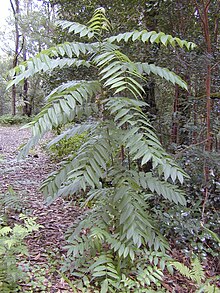Toona ciliata
| Toona ciliata | |
|---|---|

| |
| Small specimen ofToona ciliata | |
| Scientific classification | |
| Kingdom: | Plantae |
| Clade: | Tracheophytes |
| Clade: | Angiosperms |
| Clade: | Eudicots |
| Clade: | Rosids |
| Order: | Sapindales |
| Family: | Meliaceae |
| Genus: | Toona |
| Species: | T. ciliata
|
| Binomial name | |
| Toona ciliata M. Roem.
| |
| Synonyms[2] | |
| |

Toona ciliatais aforesttree in themahoganyfamilywhich grows throughoutSouth AsiafromAfghanistantoPapua New GuineaandAustralia.[3][4]
Names
[edit]It is commonly known as thered cedar(a name shared by other trees),tone,toonortoona(also applied to other members of the genusToona),Australian red cedar,[5]Burma cedar,Indian cedar,Moulmein cedaror theQueensland red cedar.It is also known asIndian mahogany.[6]Indigenous Australiannames includePolaiin theIllawarra.Wooliaon theRichmond River,Mamin&MugurpulnearBrisbane,andWootaatWide Bay.[7]Also calledAi sariainTimor-Leste.[8]
Description
[edit]The tree has extendedcompound leavesup to 90 cm with 10-14 pairs of leaflets which are narrow and taper towards the tip. Each leaflet is between 4.5 and 16 cm long. The species can grow to around 60 m (200 ft) in height and its trunk can reach 3 m (10 ft) in girth with large branches that create a spreading crown. It is one of Australia's few nativedeciduoustrees, with the leaves falling in autumn (late March) and growing back in spring (early September). The new leaf growth is reddish pink in colour.[citation needed]
The tree produces masses of white flowers that are very small and tubular in shape. The fruits are green capsules which senesces to a brown colour and tear open into star shape to release seeds, which are small and winged.[9]
Habitat
[edit]In Australia, the tree's natural habitat issubtropicalforestsofNew South WalesandQueensland,much of which has been extensively cleared. The Australian population was formerly treated as a distinctspeciesunder the nameToona australis.[10]The southernmost limit of natural distribution is on basaltic soils, growing west of thePrinces Highwaynear the village ofTermeil,south ofUlladulla,southernIllawarra,New South Wales.[11]It also occurs naturally atNorfolk Island.[12]The largest recordedT. ciliatatree in Australia grew near Nulla Nulla Creek, west ofKempsey, New South Walesand was felled in 1883.[13]
It grows best in an environment with high light levels, however in the relative darkness of the rainforest understorey, it is less susceptible to attack by thecedar tip moth.The cedar tip moth lays its eggs on the tree's leading shoot, allowing the larvae to burrow into the stem. This causes dieback and a multi-branched tree with little commercial value.[14]The tree exudes a chemical that the female cedar tip moth seeks out. This moth does not attack commercial plantings of Asian/African/Australian native meliaceas in South America. As a result, successful planting ofToona ciliatais being observed in many parts ofBrazil,including genetic improvement and clonal production.[citation needed]
Uses
[edit]The timber is red in colour, easy to work and very highly valued. It was used extensively for furniture, wood panelling and construction, including shipbuilding, and was referred to as "red gold" by Australian settlers.[15]Heavily and unsustainably exploited in the 19th and early 20th centuries, almost all the large trees have been cut out and the species is essentially commercially extinct.[16]Availability of this timber is now limited.[17]Timber is currently also harvested in New Guinea.[18]Although it is not generally a viable plantation species, trees are regularly harvested by Forestry in theAthertonregion of Queensland.[citation needed]
Other areas
[edit]The red cedar is widely planted in subtropical and tropical parts of the world as a shade tree and for its fast-growing aspect. It is grown in theHawaiian Islandsof the United States, and southern and eastern Africa. In parts ofZimbabweandSouth Africa,it has naturalised; growing to maturity and spreading from seed.[19]
Reproduction and dispersal
[edit]Toona ciliatareproduces by seed. It is a prolific seed producer and establishes readily.[6] [20]
Gallery
[edit]-
Toona ciliata- capsules and seeds
-
Toona ciliata- germinating seeds
-
Toona ciliata- seedlings
-
Toona ciliata- red leaves
-
Toona ciliatabark, tree nearMacksville, New South Wales, Australia
-
Stand of approximately 10 matureToona ciliata,south ofDrake, New South Wales,a rare sighting in this area
-
A stand ofToona ciliatanearKempsey, New South Wales
-
40-metreToona ciliata,leafless in August, withepiphyticDendrobiumorchids atBarrington Tops,Australia
-
Eight-year-old seedling-plantedToona ciliata,Campo Belo, southeastBrazil
-
Four-year-old - 17 meter clonedToona ciliata,Campo Belo, southeast Brazil
-
Clones productionToona ciliata,Campo Belo, southeast Brazil
See also
[edit]References
[edit]- ^Barstow, M. (2018)."Toona ciliata".IUCN Red List of Threatened Species.2018:e.T31332A68105144.Retrieved2 February2023.
- ^"Toona ciliataM.Roem. — The Plant List ".Retrieved10 June2017.
- ^"PlantNET - FloraOnline".Retrieved4 November2016.
- ^"Toona ciliata".Germplasm Resources Information Network.Agricultural Research Service,United States Department of Agriculture.Retrieved14 December2017.
- ^USDA, NRCS(n.d.)."Toona ciliata".The PLANTS Database (plants.usda.gov).Greensboro, North Carolina: National Plant Data Team.Retrieved11 December2015.
- ^ab"Toona ciliata(Toon Tree) ".BioNET-EAFRINET.RetrievedJanuary 27,2015.
- ^Cedar & the Cedar Getters - James Jervis. Abridged from the J & Proc. of Roy. Austr. Hist. Soc. 25 (2), 1940. Historical Records of New South Wales, Vol.2, page 283. Forestry Commission of New South Wales
- ^"Timorese Plant Names and their Origins".
- ^Toona ciliata M.Roem.BioNET-EAFRINET - Keys and Factsheets
- ^"PlantNET - FloraOnline".plantnet.rbgsyd.nsw.gov.au.Royal Botanic Gardens, Sydney.Retrieved2021-11-20.
- ^Eurobodalla Regional Botanic Gardens
- ^"Red cedar tree in Lindsay Street".Toowoomba Regional Council.Retrieved2015-01-27.
- ^"NSW Wilderness Red Index".Archived fromthe originalon 2009-09-30.
- ^"Australian Red Cedar".
- ^"Types of Timber".Time 4 Timber. Archived fromthe originalon 2009-01-20.Retrieved2009-01-21.
- ^Vader, John. (1987).Red Cedar. The Tree of Australia's History.Reed: Sydney.ISBN0-7301-0151-7
- ^"Red cedar".DAFF.
- ^"PNGTreesKey -Toona ciliata".Guide to the Trees of Papua New Guinea.Retrieved2009-01-21.
- ^"Flora of Zimbabwe".
- ^Jagdev Saw Mills















